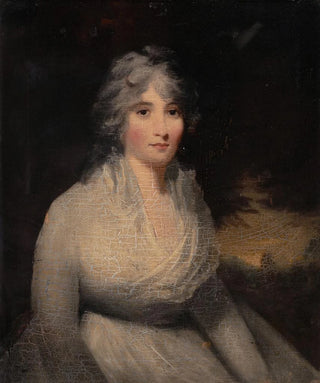Art print | Lady Margaret Falconer - School of John Hoppner


View from behind

Frame (optional)
Lady Margaret Falconer Art print - John Hoppner School – Captivating Introduction
The "Lady Margaret Falconer" art print by the John Hoppner School immerses us in the refined universe of the late 18th century, an era marked by artistic flourishing and a quest for elegance. This piece, which captures the very essence of British nobility, evokes timeless beauty, both delicate and powerful. Gazing upon this art print, one is immediately transported to aristocratic salons, where fashion and art intertwine in a harmonious dance. The meticulously rendered details, from sumptuous drapery to subtle expressions, invite an in-depth exploration of Lady Margaret's personality, while reflecting the aesthetic standards of her time.
Style and uniqueness of the work
Hoppner's style, imbued with romanticism and realism, is fully expressed in the depiction of Lady Margaret Falconer. Warm colors and play of light create an intimate atmosphere, while the carefully balanced composition guides the viewer's gaze. Every element of the canvas, from the delicate background to the carefully chosen accessories, contributes to a rich and nuanced visual narrative. The figure's posture, both majestic and approachable, reveals psychological depth that transcends a simple portrait. This art print stands out for its ability to capture not only appearance but also the soul of its subject, an achievement few artists manage with such brilliance.
The artist and his influence
John Hoppner, born in 1758, quickly established himself as one of the most prominent portraitists of his time, rivaling masters such as Sir Joshua Reynolds. His innovative approach to portraiture, combining technical finesse and emotional sensitivity, left an indelible mark on British art. Hoppner drew inspiration from the major artistic currents of his era while developing a personal style unique to him. His work not only influenced his contemporaries but also paved the way for future generations of artists, who saw in him a model of creativity and excellence. The depiction of female figures, like Lady Margaret, demonstrates his ability to celebrate beauty while

Matte finish

View from behind

Frame (optional)
Lady Margaret Falconer Art print - John Hoppner School – Captivating Introduction
The "Lady Margaret Falconer" art print by the John Hoppner School immerses us in the refined universe of the late 18th century, an era marked by artistic flourishing and a quest for elegance. This piece, which captures the very essence of British nobility, evokes timeless beauty, both delicate and powerful. Gazing upon this art print, one is immediately transported to aristocratic salons, where fashion and art intertwine in a harmonious dance. The meticulously rendered details, from sumptuous drapery to subtle expressions, invite an in-depth exploration of Lady Margaret's personality, while reflecting the aesthetic standards of her time.
Style and uniqueness of the work
Hoppner's style, imbued with romanticism and realism, is fully expressed in the depiction of Lady Margaret Falconer. Warm colors and play of light create an intimate atmosphere, while the carefully balanced composition guides the viewer's gaze. Every element of the canvas, from the delicate background to the carefully chosen accessories, contributes to a rich and nuanced visual narrative. The figure's posture, both majestic and approachable, reveals psychological depth that transcends a simple portrait. This art print stands out for its ability to capture not only appearance but also the soul of its subject, an achievement few artists manage with such brilliance.
The artist and his influence
John Hoppner, born in 1758, quickly established himself as one of the most prominent portraitists of his time, rivaling masters such as Sir Joshua Reynolds. His innovative approach to portraiture, combining technical finesse and emotional sensitivity, left an indelible mark on British art. Hoppner drew inspiration from the major artistic currents of his era while developing a personal style unique to him. His work not only influenced his contemporaries but also paved the way for future generations of artists, who saw in him a model of creativity and excellence. The depiction of female figures, like Lady Margaret, demonstrates his ability to celebrate beauty while






